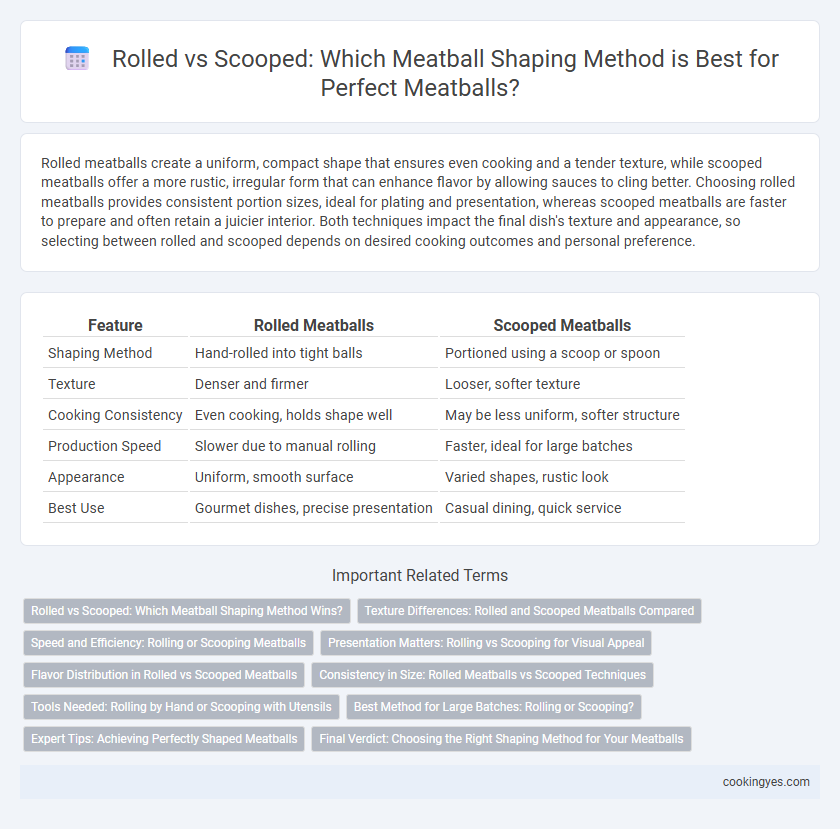Rolled meatballs create a uniform, compact shape that ensures even cooking and a tender texture, while scooped meatballs offer a more rustic, irregular form that can enhance flavor by allowing sauces to cling better. Choosing rolled meatballs provides consistent portion sizes, ideal for plating and presentation, whereas scooped meatballs are faster to prepare and often retain a juicier interior. Both techniques impact the final dish's texture and appearance, so selecting between rolled and scooped depends on desired cooking outcomes and personal preference.
Table of Comparison
| Feature | Rolled Meatballs | Scooped Meatballs |
|---|---|---|
| Shaping Method | Hand-rolled into tight balls | Portioned using a scoop or spoon |
| Texture | Denser and firmer | Looser, softer texture |
| Cooking Consistency | Even cooking, holds shape well | May be less uniform, softer structure |
| Production Speed | Slower due to manual rolling | Faster, ideal for large batches |
| Appearance | Uniform, smooth surface | Varied shapes, rustic look |
| Best Use | Gourmet dishes, precise presentation | Casual dining, quick service |
Rolled vs Scooped: Which Meatball Shaping Method Wins?
Rolled meatballs offer a uniform, compact shape that promotes even cooking and a classic appearance, while scooped meatballs, formed with an ice cream scoop or spoon, ensure consistent portion sizes and a tender texture. Rolled meatballs tend to have a denser bite due to the pressure applied by hand, whereas scooped meatballs often remain lighter and fluffier with less compression. For precision and texture control, many chefs prefer scooped meatballs, but rolled meatballs dominate when structure and traditional aesthetics are prioritized.
Texture Differences: Rolled and Scooped Meatballs Compared
Rolled meatballs create a denser, firmer texture due to compacting the meat tightly with hands, which limits air pockets and moisture retention. Scooped meatballs yield a lighter, more tender bite as the loose packing preserves small air gaps and allows moisture to permeate evenly during cooking. Texture variations impact mouthfeel significantly, with rolled meatballs providing chewiness and scoop-shaped ones offering softness and juiciness.
Speed and Efficiency: Rolling or Scooping Meatballs
Scooping meatballs with a disher or scoop significantly boosts speed and consistency, allowing for uniform portions that cook evenly. Rolling meatballs by hand offers more control over shape but is slower and less efficient for large batches. For commercial kitchens prioritizing high volume, scooping provides a faster, more efficient method than rolling.
Presentation Matters: Rolling vs Scooping for Visual Appeal
Rolled meatballs create a uniform, smooth surface that enhances visual appeal and consistency, making them ideal for elegant presentations. Scooped meatballs offer a rustic texture with irregular shapes, adding a handcrafted charm that works well for casual dining settings. Choosing between rolled or scooped meatballs influences both the aesthetic and perceived quality of the dish.
Flavor Distribution in Rolled vs Scooped Meatballs
Rolled meatballs create a uniform texture that allows for even cooking, but the denser structure may limit flavor infusion, resulting in a more consistent yet milder taste throughout. Scooped meatballs often have a looser texture, promoting better absorption of seasonings and moisture, which enhances flavor distribution and juiciness in each bite. The choice between rolled and scooped methods directly impacts the balance of texture and flavor intensity in meatball preparation.
Consistency in Size: Rolled Meatballs vs Scooped Techniques
Rolled meatballs offer precise control over size and shape, ensuring uniform cooking and consistent presentation. Scooped meatballs, created using a cookie scoop or spoon, provide quick portioning but may result in slight size variations impacting even cooking. Consistency in size is crucial for maintaining texture and flavor, with rolled methods favoring accuracy and scooped techniques prioritizing speed.
Tools Needed: Rolling by Hand or Scooping with Utensils
Rolling meatballs by hand requires minimal tools, typically just clean hands, which allows for precise control over size and texture. Scooping with utensils like ice cream scoops or spoons ensures uniformity and consistent portion sizes, enhancing even cooking and presentation. Choosing between hand-rolling and scooping depends on desired meatball shape, size consistency, and efficiency in preparation.
Best Method for Large Batches: Rolling or Scooping?
Rolling meatballs by hand ensures uniform texture and allows precise size control, ideal for achieving consistent cooking results in large batches. Scooping with a melon baller or ice cream scoop speeds up production and guarantees portion uniformity, reducing prep time significantly. For large-scale operations, scooping is often preferred due to its efficiency and consistency, whereas rolling suits artisanal approaches prioritizing texture.
Expert Tips: Achieving Perfectly Shaped Meatballs
Rolled meatballs provide a uniform shape and consistent texture, making them ideal for even cooking and professional presentation. Scooping meatballs with a disher ensures consistent size, which helps maintain juiciness and reduces cooking time variability. Experts recommend chilling the mixture before shaping to prevent sticking and achieve perfectly smooth, round meatballs every time.
Final Verdict: Choosing the Right Shaping Method for Your Meatballs
Rolled meatballs offer a uniform, dense texture that holds well during cooking, making them ideal for baking or frying where even browning is desired. Scooped meatballs deliver a softer, more tender bite with uneven edges that enhance sauce absorption, perfect for slow-cooked dishes like meatball subs or Swedish meatballs. Selecting the right shaping method depends on the cooking technique and desired meatball consistency, ensuring optimal flavor and texture in every bite.
Rolled vs Scooped for Meatball Shaping Infographic

 cookingyes.com
cookingyes.com